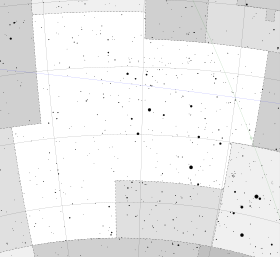Loading AI tools
HR 7703 (Gliese 783, 279 G. Sagittarii) is a binary star system in the constellation of Sagittarius. The brighter component has an apparent visual magnitude of 5.31,[2] which means it is visible from suburban skies at night. The two stars are separated by an angle of 7.10″, which corresponds to an estimated semimajor axis of 56.30 AU for their orbit.[11]
| Observation data Epoch J2000 Equinox J2000 | |
|---|---|
| Constellation | Sagittarius |
| Right ascension | 20h 11m 11.93827s[1] |
| Declination | –36° 06′ 04.3610″[1] |
| Apparent magnitude (V) | 5.31[2]/11.50[3] |
| Characteristics | |
| Spectral type | K2.5 V[4] + M4 V[5] |
| U−B color index | +0.43[2] |
| B−V color index | +0.85[2] |
| Astrometry | |
| Radial velocity (Rv) | –129.4[6] km/s |
| Proper motion (μ) | RA: +456.99[1] mas/yr Dec.: –1574.64[1] mas/yr |
| Parallax (π) | 166.3272 ± 0.1065 mas[7] |
| Distance | 19.61 ± 0.01 ly (6.012 ± 0.004 pc) |
| Absolute magnitude (MV) | 6.53[8] |
| Details | |
| HR 7703 A | |
| Mass | 0.65[9] M☉ |
| Radius | 0.66[9] R☉ |
| Luminosity | 0.26[9] L☉ |
| Surface gravity (log g) | 4.48 ± 0.17[9] cgs |
| Temperature | 5,075 ± 43[9] K |
| Metallicity [Fe/H] | –0.56 ± 0.04[9] dex |
| Rotational velocity (v sin i) | 1.8 ± 0.2[8] km/s |
| Age | 7.7[10] Gyr |
| HR 7703 B | |
| Mass | 0.24[11] M☉ |
| Radius | 0.28[3] R☉ |
| Other designations | |
| HR 7703 A: LHS 486, LFT 1529, LTT 7988 | |
| HR 7703 B: LHS 487, LFT 1530, LTT 7989 | |
| Database references | |
| SIMBAD | The system |
| A | |
| B | |
Location of HR 7703 in the constellation Sagittarius | |
Based upon an annual parallax shift of 0.16625 arc seconds as measured by the Hipparcos satellite, this system is 19.62 light-years (6.015 parsecs) from Earth. It is approaching the Solar System at a velocity of approximately 129 kilometers per second.[6] At this rate, it will make its closest approach in 41,100 years when it comes to within 6.7 light-years (2.05 parsecs) of the Sun.[13]
This star system has been examined for an excess of radiation in the infrared. The presence of an infrared excess can be taken as an indication of a debris disk orbiting the star. However, no such excess was discovered around HR 7703.[14] Radial velocity data collected over a period of 12 years was examined for signs of periodicity caused by a planet orbiting at a distance of 3–6 AU, but none was detected.[15] A slight linear trend in the radial velocities of the primary is probably due to the companion star.[16]
Wikiwand in your browser!
Seamless Wikipedia browsing. On steroids.
Every time you click a link to Wikipedia, Wiktionary or Wikiquote in your browser's search results, it will show the modern Wikiwand interface.
Wikiwand extension is a five stars, simple, with minimum permission required to keep your browsing private, safe and transparent.
